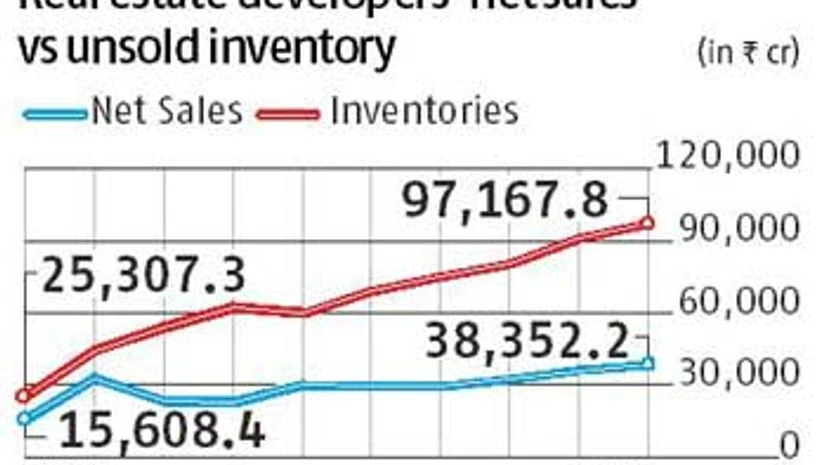Real estate developers continue to pile up inventory at a rapid pace. For the entire industry, unsold stock stood at 1.2 billion sq ft at the end of the April-June 2016 quarter, according to a survey by real estate consultancy Liases Foras.
In the June quarter, unsold inventory increased by two per cent on a sequential basis and 17 per cent on a year-on-year (y-o-y) basis.
The value of the inventory works out to Rs 6 lakh crore, assuming an average selling price of Rs 5,000 per sq ft. “As sales growth continues to lag behind new launches, unsold inventory continues to climb for the industry. In recent times, we have seen a slowdown in new project launches but it will take the industry nearly three years to clear the current inventory, based on the present sale or absorbency rate,” said Pankaj Kapoor, managing director, Liases Foras.
In the June quarter, unsold inventory increased by two per cent on a sequential basis and 17 per cent on a year-on-year (y-o-y) basis.
| REALTY WATCH |
|
The value of the inventory works out to Rs 6 lakh crore, assuming an average selling price of Rs 5,000 per sq ft. “As sales growth continues to lag behind new launches, unsold inventory continues to climb for the industry. In recent times, we have seen a slowdown in new project launches but it will take the industry nearly three years to clear the current inventory, based on the present sale or absorbency rate,” said Pankaj Kapoor, managing director, Liases Foras.
For the country’s top 25 listed real estate developers, the story isn’t any different. Their unsold stock reached an all-time high of Rs 97,000 crore at the end of March 2016, up 6.7 per cent y-o-y. Going by their FY16 revenue, it will take developers more than two-and-a-half years to liquidate this inventory.
The companies in the Business Standard sample reported net sales of Rs 38,300 crore in FY16, up 7.3 per cent y-o-y. All 23 of the 25 companies in the sample reported a growth in their inventory in FY16. Of these, the inventory of 13 companies grew faster than revenue last year. (See adjoining chart)
The analysis is based on the 10-year financials of the top listed real estate developers. Companies report their inventory data in their balance sheet at the end of every financial year. Some of the companies in the sample include DLF, Unitech, Prestige Estates, Godrej Properties, Mahindra Lifespaces, Peninsula Land, Indiabulls Real Estate, Oberoi Realty, Hubtown, Omaxe, HDIL, Phoenix Mills, Brigade Enterprises, Kolte-Patil and Sobha, among others.
Among individual companies, DLF had the highest unsold inventory of around Rs 17,500 crore at the end of March, equivalent to around two years of its sales. It was followed by HDIL (Rs 13,600 crore) and Indiabulls Real Estate (Rs 5,400 crore).
A large part of the inventory is being funded through debt.
The combined debt for the companies in the sample was up 15 per cent y-o-y to Rs 76,600 crore in FY16. The industry’s debt-equity ratio (on a gross basis) reached a seven-year high of 0.8x at the end of FY16, while interest coverage ratio (ICR) declined to a decade low of 1.8x. A ratio of operating profit to interest payment, ICR indicates a firm’s debt servicing ability and a higher number is desirable.
According to Liases Foras, the industry sold around 79 million sq ft of property in the top eight urban centres during the April-June quarter, up nine per cent on y-o-y basis and down one per cent over the January-March 2016 quarter. These eight urban centres - Mumbai region, National Capital Region (NCR), Bengaluru, Kolkata, Chennai, Hyderabad, Pune and Ahmedabad - account for nearly 75 per cent of all real estate projects in the country, in terms of value.
At the city level, developers in Delhi-NCR top the chart with 366 million sq ft of unsold stock at end of June 2016 quarter. It is followed by Mumbai Metropolitan Region, with 267 million sq ft and Bengaluru with 178 million sq ft. The survey, however, suggests that inventory is rising the fastest in Kolkata (up 52 per cent y-o-y), followed by Hyderabad (35 per cent) and Mumbai region (33 per cent). Experts say the luxury segment is facing major problems, while the value segment is still showing some traction. “The luxury segment, with large ticket prices, is finding it hard to clear inventory, while mid-income housing continues to see strong demand,” wrote Abhishek Bhandari of Macquarie in his recent report on the real estate sector. He expects a decline in inventory or at least a slower growth due to slowdown in new launches. “Launches remain weak, as developers are focused on clearing inventory in ongoing projects, with the weakest being the NCR region (no new launches in Noida and just four projects launched in Gurgaon),” added Bhandari.

)
